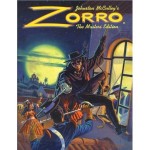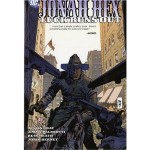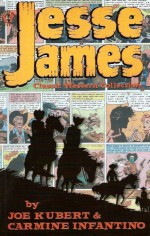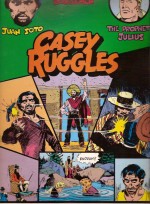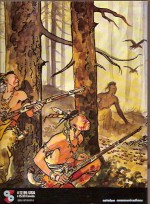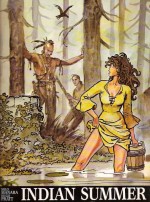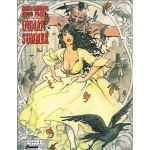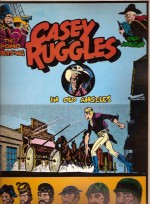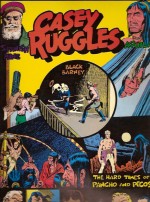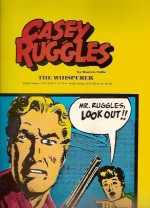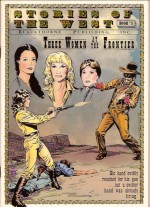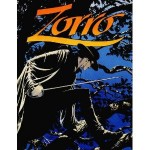
By Nedaud & Carlo Marcello (Eclipse Books)
ISBN: 978-1-89172-920-1 hardcover,  978-0-91303-512-2 paperback
One the earliest masked heroes and still phenomenally popular throughout the world is perennial film favourite “El Zorro, The Foxâ€, originally created by jobbing writer Johnston McCulley in 1919 in a five part serial entitled ‘The Curse of Capistrano’ and debuting in All-Story Weekly from August 6th to 6th September. The tale was subsequently published by Grossett & Dunlap in 1924 as The Mark of Zorro and further reissued in 1959 and 1998 by MacDonald & Co. and Tor respectively.
Famously Hollywood royalty Douglas Fairbanks and Mary Pickford read the ‘The Curse of Capistrano’ in All-Story Weekly on their honeymoon and immediately optioned the adventure to be the first film release from their new production company/studio United Artists.
The Mark of Zorro was a global movie sensation in 1920 and for years after, and New York based McCulley re-tailored his creation to match the extremely different filmic incarnation. The Caped Crusader aptly fitted the burgeoning genre that would soon be people by the likes of The Shadow, Doc Savage and the Spider.
Rouben Mamoulian’s filmic remake of The Mark of Zorro further ingrained the Fox into the World’s psyche, and as the prose exploits continued in a variety of publications Dell began a comicbook version in 1949. When Walt Disney began a hugely popular Zorro TV show in 1957 the comics series was redesigned to capitalise on it and the entertainment corporation began a decades-long strip incarnation of “their†version of the character in various areas of the world. This classy tome collects half of the dozen stories produced for a French iteration which originally ran in Le Journal de Mickey, by veteran Italian artist Raphaël Carlo Marcello and relative enigma Nedaud, of whom I sadly know very little.
The celebrated and supremely stylish Marcello (1929-2007) moved to Paris in 1948 and began his long and prestigious career drawing Loana et le Masque Chinois in Aventures de Paris-Jeunes and Nick Silver for Collection Victoire before switching to newspaper strips for Opera Mundi in 1950, illustrating La Découverte du Monde and L’Histoire de Paris before adapting Ben Hur, Jane Eyre and the Bible.
In 1952, he joined Héroic, working on Oliver Twist, Gil Blas and Bug Jargal, then began a 15-year run on Le Cavalier Inconnu (1955-1970) in Pépito. His maintained ties to newspapers throughout and continued general interest literary adaptations for Mondial-Presse.
In 1956, he contributed Bob Franck to Bugs Bunny magazine and numerous strips to Lisette, Monty, Mireille, L’Intrépide/Hurrah and Rintintin. He moved to Pif Gadget in 1970, collaborating on his signature series Docteur Justice with prolific scenarist/writer Jean Ollivier as well as Amicalement Vôtre (a TV adaptation scripted Spanish by the legendary Victor Mora), Taranis (scripts by Ollivier & Mora), Tarao (by Roger Lécureux) and La Guerre du Feu.
Never stopping for breath Marcello illustrated John Parade, Patrouilleur de l’Espace, in Le Journal des Pieds Nickelés, the Larousse series L’Histoire de France en Bandes Dessinées, La Découverte du Mond and L’Histoire du Far West until 1985 when he joined Le Journal de Mickey to create Le Regard du Tigre, Le Club des Cinq and the subject of this collection.
Solidly based on the 1950s TV series Zorro ran for a year (1985-1986): 12 stirring fast-paced, swashbuckling romps, the first half of which are collected in this slim, full colour European-format album. After these thundering epics Marcello carried on improving, drawing sci fi extravaganza Cristal, epigrammatic short stories Voulez-vous de Nos Nouvelles?, Michael Jackson, Wayne Thunder, L’Épopée du Paris Saint-Germain and mature-reader series Nuit Barbare and Amok. In 1991 he returned to his hometown of Vintimille where he ended his days drawing episodes of iconic Italian series’ Tex and Zagor for Il Giornalino and Bonelli publishing.
Don Diego de la Vega is the foppish son of a noble house in old California when it was a Spanish Possession, who used the masked persona of Zorro the Fox to right wrongs, defend the weak and oppressed – particularly the pitifully maltreated natives and Indians – and thwart the schemes of Capitan Monastario, his bumbling sergeant Garcia and the despicable Governor determined to milk the populace for all they had. In his crusade Diego was aided by Bernardo (the deaf-mute manservant retained for the assorted TV and movies) and the good-will of the oppressed and overtaxed people of Los Angeles.
Whenever Zorro appeared he left his mark – a bold letter “Z†– carved into walls, doors, curtains, but never, ever faces…
Written for an all-ages audience these stories, each around ten pages long, play out an exotic eternal, riotous game of tag, beginning with ‘Wanted!’ as a huge reward galvanises the town to hunt the Fox, until Zorro turns the tables by capturing the Capitan and ransoming him back, thereby emptying the military coffers…
Next, in ‘The Assassins’ bandits posing as patriotic rebels capture the masked hero as part of their plan to murder the Governor and loot the ever-growing township, whilst ‘Double Agent’ sees Monastario blackmail a girl into betraying the wily avenger, but again misjudges Zorro’s ability to connect with the downtrodden Californians…
‘The Scarecrow’ finds the hero thwart a plot to discredit the reputation of Zorro when the unscrupulous Capitan employs a murderous masked impostor, after which ‘Tight as a Noose’ sees Monastario arrest Diego’s father Don Alejandro for treason to entrap the mysterious vigilante, and this rip-roaring rollercoaster ride concludes with ‘The Winds of Rebellion’ as the latest illegal tax rouses the town council against the Capitan and Zorro gets involved to prevent bloodshed…
Full-bodied, all-action and beautifully realised these classy adventures of a global icon are long overdue for a comprehensive and complete re-release, but until then at least this terrific tome is still readily available in both hardback and softcover through many online retailers.
® and © 1986 Zorro Productions, Inc. All Rights Reserved.

